SEO
7 Marketing Objective Examples (+ How to Set Yours Right)
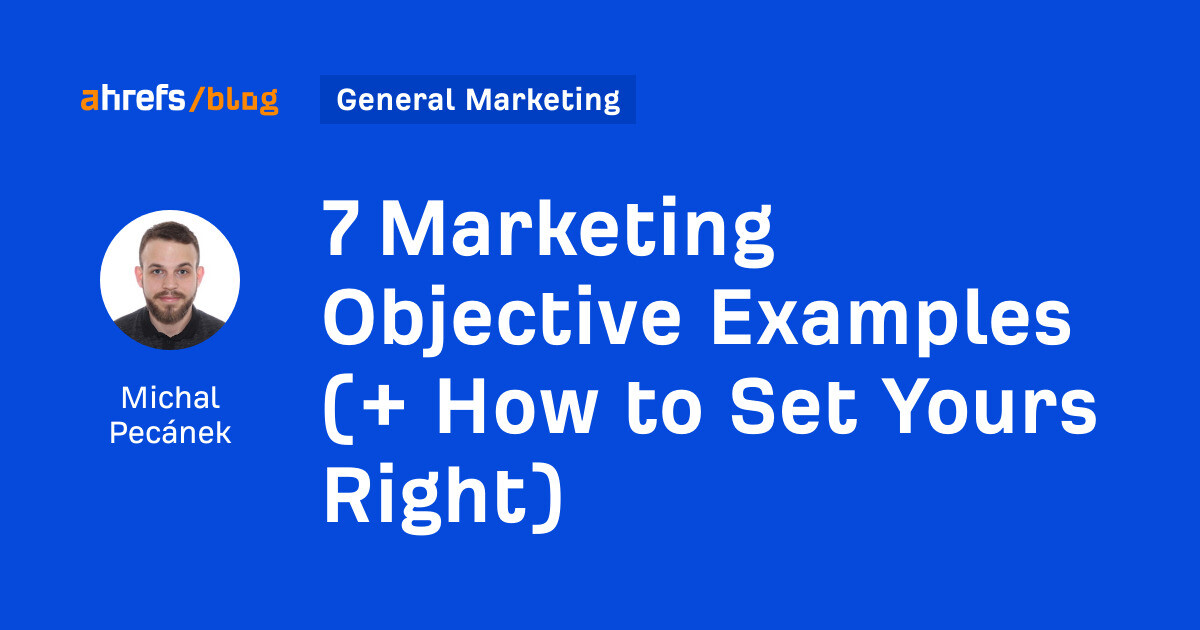
The hard truth about marketing objectives is that you shouldn’t look at a few examples and choose those that seem to fit the best. The examples should only be used as inspiration.
It’s on you to set specific marketing objectives because every business is different and the highest priority needs in marketing change over time. Deciding where your marketing focus should be for the year ahead is an essential part of every marketing plan.
In this article, we’ll dive into examples of great marketing objectives, including ways to measure them. It’s then followed by the best practices you should apply to either adjust those examples according to your needs or come up with your own marketing objectives from scratch.
But first…
Marketing objectives are specific and realistic outcomes that your company wants to achieve with its marketing efforts over a certain period of time. They guide what you should focus your marketing activities on, most commonly for the year ahead.
Great marketing objectives provide benchmarks to evaluate your marketing performance, which is key to making changes to your marketing strategy and plans.
Let’s dive into the examples.
Coming up with a good marketing objective is one thing. Being able to properly track the progress toward it is another.
That’s why each point here contains a short “How to measure it” section pointing you toward metrics, KPIs, and systems you can use to follow through.
1. Increase share of voice (SOV)
Example objective: Increase SOV from 11% to 16% by the end of 2023.
Share of voice (SOV) is traditionally a measure of your advertising share compared to competitors. However, with most brands now fighting for visibility on organic channels like social and search, we can broaden that definition to how visible your brand is in the market.
This is an excellent marketing objective because there’s a strong relationship between SOV and market share. Once your SOV is higher than your market share, you create excess SOV (eSOV). Your market share should follow in the same direction in the long run.

Of course, this is an undeniably tricky metric to track across all channels. The solution is to break the objective down into your most important channels.
Here are a few examples:
Increase organic search visibility in the U.S. from 6% to 8% by the end of 2023.
Increase search ad impression share from 47% to 65% in the U.S. among Site Audit tool buyers by the end of 2023.
Increase marketing podcast audience monthly reach from 300,000 to 500,000 by the end of 2023.
How to measure it
Measuring SOV depends on your choice of channel. For example, for organic search, the simplest method is to track your main keywords in Ahrefs’ Rank Tracker, add your competitors’ domains, and check the SOV in the Competitors overview tab.
Here’s what it looks like for keywords we target on our blog:
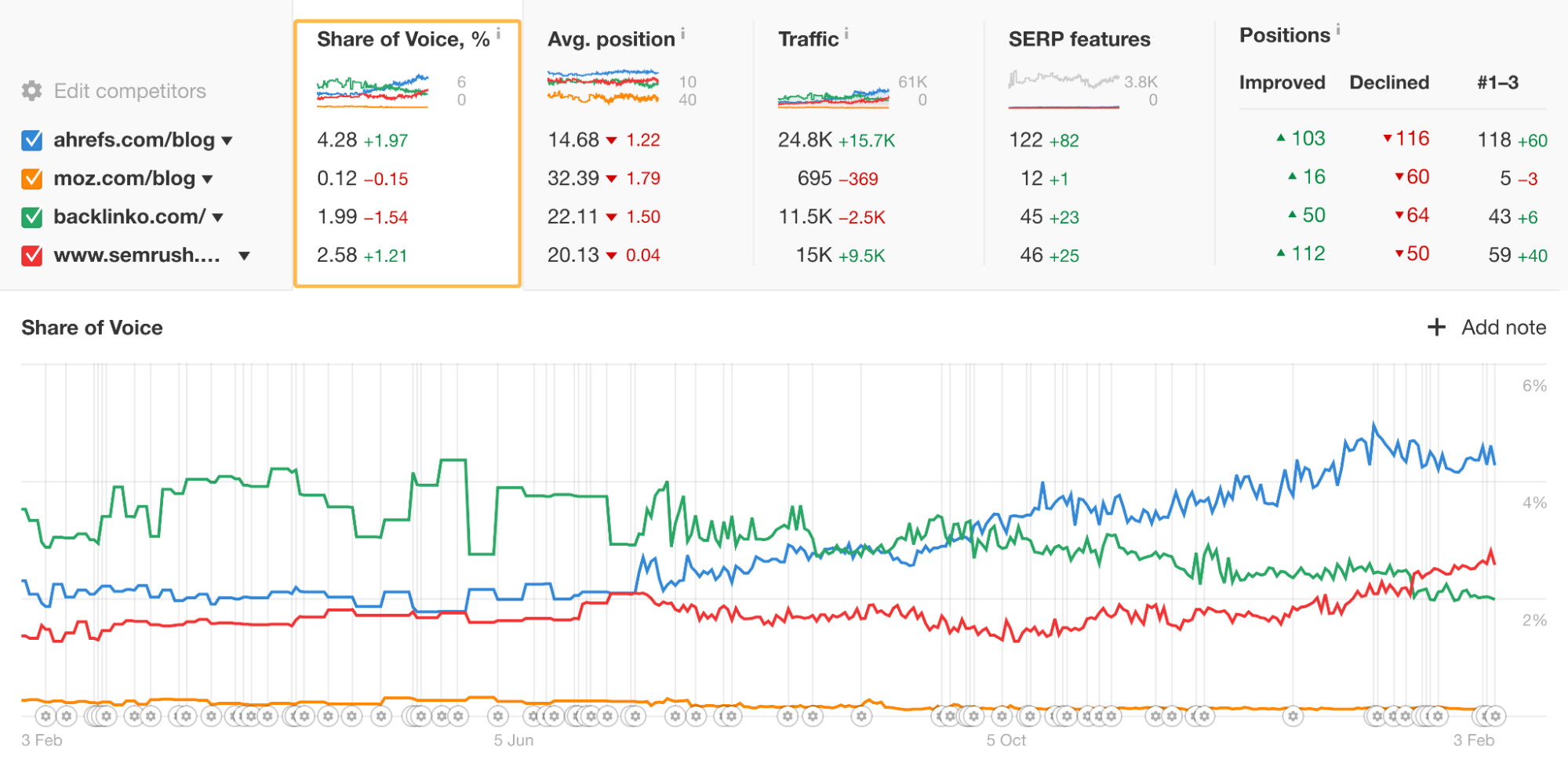
It shows you the percentage of all clicks from tracked keywords that land on your and your competitors’ websites.
This is a topic on its own, so check the following guide if you’re curious about measuring SOV across channels.
2. Increase brand awareness
Example objective: Increase unaided awareness of our brand among the total market of marketers from 31% to 38% by the end of 2023.
Brand awareness represents your brand’s level of familiarity among your target audience. For example, the brand that first comes to mind when you think of electric cars is probably Tesla, not Rivian. That’s because Tesla enjoys a higher level of brand awareness among consumers.
There are multiple metrics that you can investigate regarding your brand awareness:
- Aided brand awareness – The percentage of respondents who are aware of your brand when asked explicitly.
- Unaided brand awareness – Also known as brand recall, this is the percentage of respondents who mention your brand on their own without any prompt.
- Top-of-mind awareness – The percentage of respondents who mention your brand as the first one in your niche.
- Brand recognition – The percentage of respondents who recognize your brand based on your logo, visual identity, or other brand assets.
How to measure it
Measuring brand awareness metrics requires market research resources because you need answers from a representative sample from your market. Market research agencies specialize in this and are your only option to get comprehensive data.
However, if you already measure SOV, you can use it as a rough proxy metric for brand awareness.
3. Improve brand perception
Example objective: Increase perception that we’re the best SEO toolset from 44% to 51% by the end of 2023.
Familiarity with your brand is one thing, but do people resonate with how you want them to perceive your brand or products? In other words, does your positioning work? Is your marketing communication creating the right associations around your brand?
If you get unsatisfactory answers to these questions, then this objective may be for you. You’ll also likely get other useful information regarding your brand perception. This is all a great starting point to work on your communication and positioning.
How to measure it
Similar to brand awareness, this one still requires surveys and likely the help of specialized agencies. But in this case, you’re able to gather a good chunk of the data yourself by surveying your current and lost customers.
You can also monitor your brand’s mentions to see how people talk about it online. Tools like Brand24 recognize the sentiment, so that may be a good starting point if you’re simply looking to improve your reputation.
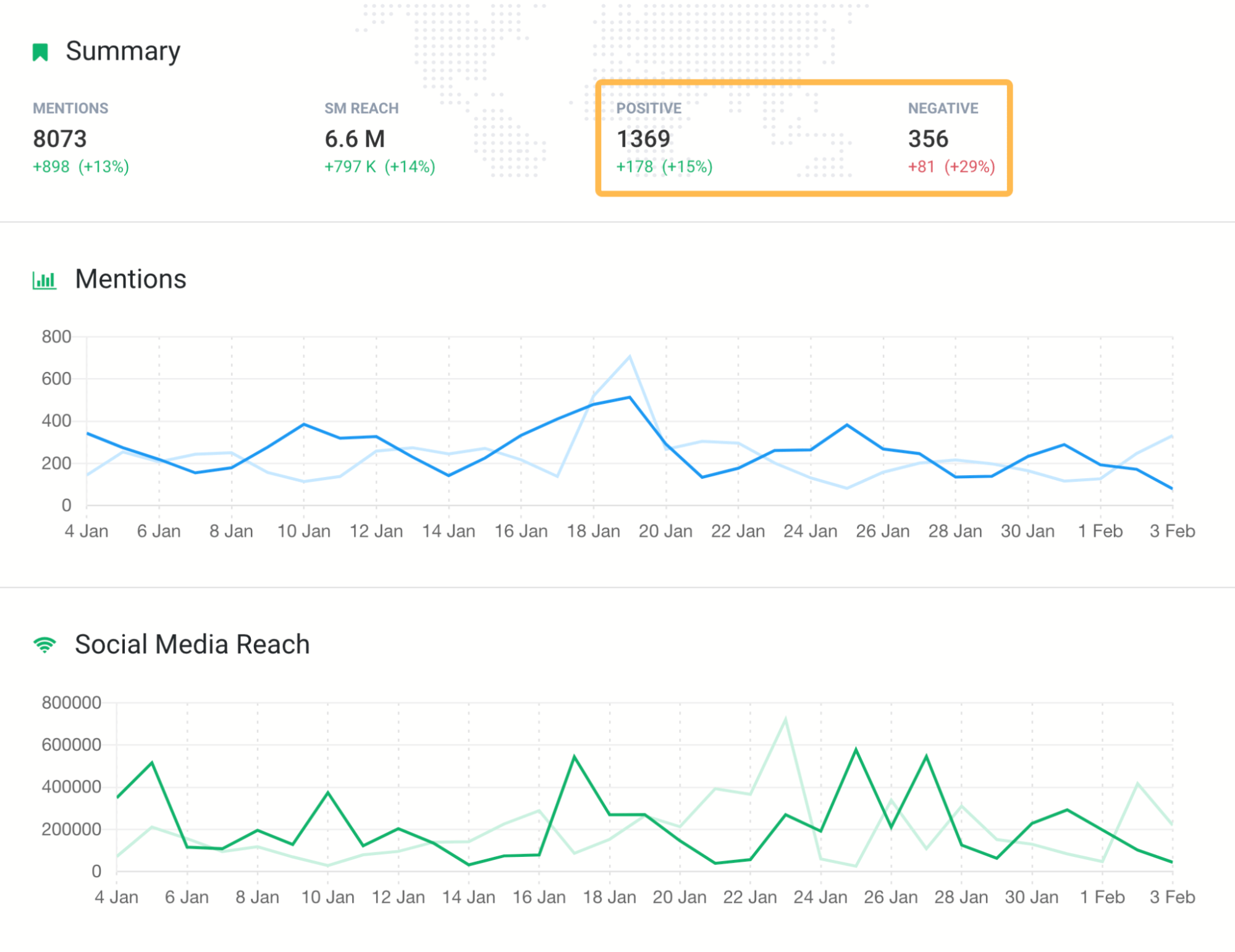
4. Boost sales growth
Example objective: Increase annual recurring revenue (ARR) from $104 million to $120 million by the end of 2023.
Boosting sales growth is the first short-term marketing objective on our list tied directly to revenue or profit. You need to know which financial metrics make the most sense to measure based on your business model and planning.
Sales growth can also be tied to a specific product or service. This makes options for sales growth objectives almost limitless.
How to measure it
Simply get data from your Customer Relationship Management (CRM) platform, checkout systems, or other sorts of financial dashboards.
On the other hand, don’t rely on the numbers in your Google Analytics for this. They’re skewed by default and may not track everything properly.
5. Acquire more users or customers
Example objective: Increase monthly active users (MAU) of Ahrefs Webmaster Tools from 750,000 to 1.2 million by the end of 2023.
Accelerating your user base growth doesn’t necessarily mean more profit, but it has implications that are way beyond any financial metrics.
For example, we launched a free version of our SEO toolset called Ahrefs Webmaster Tools in September 2020. Increasing our word of mouth, broadening the user base, and familiarizing more people with our product lead to long-term growth.
How to measure it
Use numbers from your CRM. Of course, this is not a worthwhile marketing objective for physical product manufacturers selling in supermarkets.
6. Generate more marketing qualified leads (MQLs)
Example objective: Increase the generated number of MQLs from 5,676 in 2022 to 6,500 in 2023.
A marketing qualified lead (MQL) is any lead that indicates interest in your brand and products. That can range from downloading an ebook to sending a contact form.
This objective can be a great fit for any subscription-based business with sales reps who’ll be taking over those leads and trying to turn them into customers.
How to measure it
Tracking MQLs can be quite easy these days. You need to set up a lead scoring system that automatically evaluates your incoming leads based on data points like:
- Estimated purchasing power of the company.
- User behavior and actions taken in your app or website.
- Trial tier and setup.
- Anything the lead said to your customer rep or sales team (e.g., that they’re looking for a new solution).
- Any other data you collect from forms or lead magnets.
Some CRM platforms like HubSpot have a lead scoring functionality built in, but I suggest you consult this with a CRM analytics expert to get everything right from the start.
7. Increase customer lifetime value (CLV)
Example objective: Increase CLV among enterprise customers from $44,500 to $55,000 by the end of 2023.
Customer lifetime value (CLV) is a metric that estimates how much money an individual customer will spend on your products or services. Increasing your average customer’s worth not only improves your financial metrics but also allows you to spend more on acquiring new customers.
How to measure it
This is the most basic formula to calculate CLV:
Avg. Order Value x Avg. Annual Purchase Frequency x Avg. Customer Lifespan
If your AOV is $100, customers buy the product four times a year, and they stay loyal to your company for three years on average, the CLV will be 100*4*3 = $1,200.
You work with three different metrics in your CLV objectives. Improve any of those metrics, and your CLV goes up. For example, here’s a whole guide I wrote about decreasing churn rate, i.e., increasing your average customer lifespan.
You should now have enough inspiration to come up with your own objectives, so it’s time to go through three best practices that will ensure they fit well with your marketing strategy and plans.
Start from your most important marketing needs
Increasing your conversion rates is always nice. But if only 1% of your target audience is aware that your brand exists, you may want to reassess your priorities.
Look, no one but your team can tell what’s your biggest marketing opportunity to tackle. This is why it’s crucial to do proper market research that feeds into your marketing strategy—you’d be playing a guessing game otherwise.
Your brand diagnosis along with all the data from CRM and analytics systems have the answers. You can’t set the best marketing objectives if you don’t look at the big picture.
Well, the big picture can be an actual picture. It’s called a marketing funnel, and most of the objectives we talked about here influence its “flow”:
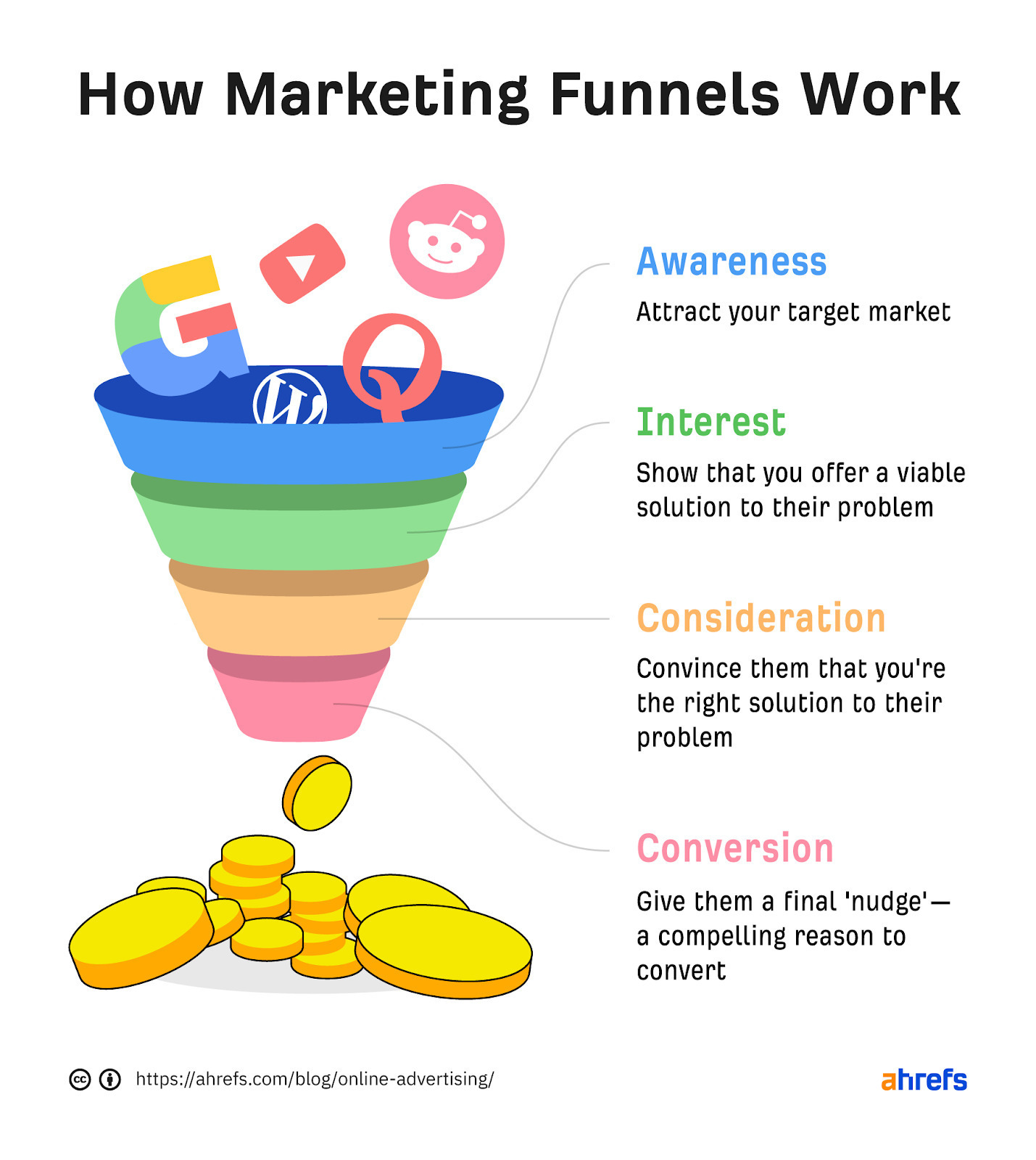
People drop off at each of those stages. Not everyone who sees your Facebook ad will click. Not everyone who clicks will sign up for your newsletter. Not everyone who signs up for your newsletter will buy… you get the idea.
You need to measure where the most drop-offs occur and then take steps to rectify the issue.
But keep in mind that maybe the biggest opportunity lies in feeding way more people into the funnel if we circle back to the brand awareness vs. conversions prioritization I mentioned earlier.
So identify the most significant bottlenecks and choose KPIs that will track your progress toward fixing them. Here are a few ideas for each stage of the funnel:
- Awareness – SOV, brand awareness, traffic quantity.
- Interest – Email subscribers, returning visitors.
- Consideration – Traffic quality.
- Conversion – Conversion rates, sales, AOV.
Of course, conversion is just the first win. Then comes the retention stage where you may want to improve metrics like NPS, churn rate, or customer lifespan.
Be aligned with SMART criteria
You probably noticed a pattern in all the examples—they align with SMART objectives, a widespread management concept that stands for:
- Specific – Clearly state the desirable outcome and answer “who, what, when, how much, etc.”
- Measurable – You must be able to track progress with KPIs.
- Achievable – Be bold with your goals but also be realistic; use current growth as a benchmark.
- Relevant – Does the objective align with your overall marketing and business strategy?
- Timely – Set up a time frame for achieving the goal.
Each objective example from earlier was aligned with all of these criteria. Yours should too. This is best illustrated if we dissect one of our objectives:
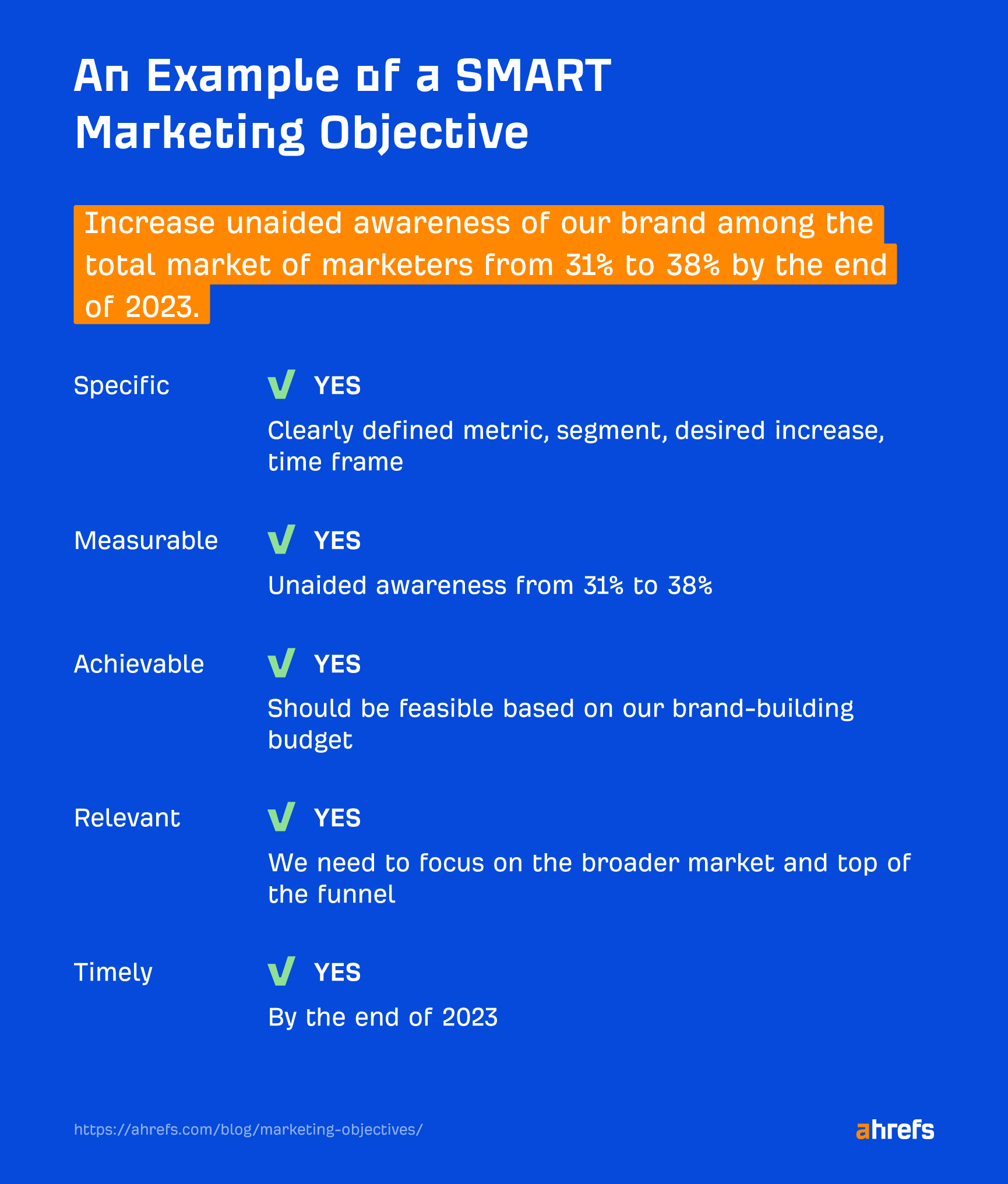
Focus on only one or two strategic objectives
You can come up with tons of marketing objectives, but that doesn’t mean you should. As Michael Porter would say, strategy is deciding what not to do.
So here are a couple of golden rules for choosing:
- Less is more – The fewer objectives a marketing campaign has, the more effective it is. In fact, having just one or two strategic objectives works best. This is based on analyzing campaigns that were submitted for Effies awards, a marketing version of the Oscars.
- Focus on both short and long term – Achieving your marketing objectives should result in improving both short- and long-term marketing KPIs. In other words, have objectives that directly translate into more profit and others that help with brand building.
As a general rule, the ideal balance between marketing spend on sales uplift and brand building is roughly 40:60. It’s one of the most important marketing concepts to keep in mind.

There’s a whole publication around this concept. The key takeaway is that brand building is proven to be the primary driver of long-term growth and success.
So choose and balance your objectives accordingly.
Final thoughts
We’ve got the strategic objectives covered. It’s the main component for planning your marketing activities for the year ahead.
While we talked about ruthless prioritization and “less is more,” remember that this applies only to the big picture. Your strategic objectives should be branched out into many smaller tactical goals, usually per each marketing channel.
This is the way of strategic marketing planning.
Got any questions? Ping me on Twitter.
SEO
Google Further Postpones Third-Party Cookie Deprecation In Chrome

Google has again delayed its plan to phase out third-party cookies in the Chrome web browser. The latest postponement comes after ongoing challenges in reconciling feedback from industry stakeholders and regulators.
The announcement was made in Google and the UK’s Competition and Markets Authority (CMA) joint quarterly report on the Privacy Sandbox initiative, scheduled for release on April 26.
Chrome’s Third-Party Cookie Phaseout Pushed To 2025
Google states it “will not complete third-party cookie deprecation during the second half of Q4” this year as planned.
Instead, the tech giant aims to begin deprecating third-party cookies in Chrome “starting early next year,” assuming an agreement can be reached with the CMA and the UK’s Information Commissioner’s Office (ICO).
The statement reads:
“We recognize that there are ongoing challenges related to reconciling divergent feedback from the industry, regulators and developers, and will continue to engage closely with the entire ecosystem. It’s also critical that the CMA has sufficient time to review all evidence, including results from industry tests, which the CMA has asked market participants to provide by the end of June.”
Continued Engagement With Regulators
Google reiterated its commitment to “engaging closely with the CMA and ICO” throughout the process and hopes to conclude discussions this year.
This marks the third delay to Google’s plan to deprecate third-party cookies, initially aiming for a Q3 2023 phaseout before pushing it back to late 2024.
The postponements reflect the challenges in transitioning away from cross-site user tracking while balancing privacy and advertiser interests.
Transition Period & Impact
In January, Chrome began restricting third-party cookie access for 1% of users globally. This percentage was expected to gradually increase until 100% of users were covered by Q3 2024.
However, the latest delay gives websites and services more time to migrate away from third-party cookie dependencies through Google’s limited “deprecation trials” program.
The trials offer temporary cookie access extensions until December 27, 2024, for non-advertising use cases that can demonstrate direct user impact and functional breakage.
While easing the transition, the trials have strict eligibility rules. Advertising-related services are ineligible, and origins matching known ad-related domains are rejected.
Google states the program aims to address functional issues rather than relieve general data collection inconveniences.
Publisher & Advertiser Implications
The repeated delays highlight the potential disruption for digital publishers and advertisers relying on third-party cookie tracking.
Industry groups have raised concerns that restricting cross-site tracking could push websites toward more opaque privacy-invasive practices.
However, privacy advocates view the phaseout as crucial in preventing covert user profiling across the web.
With the latest postponement, all parties have more time to prepare for the eventual loss of third-party cookies and adopt Google’s proposed Privacy Sandbox APIs as replacements.
Featured Image: Novikov Aleksey/Shutterstock
SEO
How To Write ChatGPT Prompts To Get The Best Results

ChatGPT is a game changer in the field of SEO. This powerful language model can generate human-like content, making it an invaluable tool for SEO professionals.
However, the prompts you provide largely determine the quality of the output.
To unlock the full potential of ChatGPT and create content that resonates with your audience and search engines, writing effective prompts is crucial.
In this comprehensive guide, we’ll explore the art of writing prompts for ChatGPT, covering everything from basic techniques to advanced strategies for layering prompts and generating high-quality, SEO-friendly content.
Writing Prompts For ChatGPT
What Is A ChatGPT Prompt?
A ChatGPT prompt is an instruction or discussion topic a user provides for the ChatGPT AI model to respond to.
The prompt can be a question, statement, or any other stimulus to spark creativity, reflection, or engagement.
Users can use the prompt to generate ideas, share their thoughts, or start a conversation.
ChatGPT prompts are designed to be open-ended and can be customized based on the user’s preferences and interests.
How To Write Prompts For ChatGPT
Start by giving ChatGPT a writing prompt, such as, “Write a short story about a person who discovers they have a superpower.”
ChatGPT will then generate a response based on your prompt. Depending on the prompt’s complexity and the level of detail you requested, the answer may be a few sentences or several paragraphs long.
Use the ChatGPT-generated response as a starting point for your writing. You can take the ideas and concepts presented in the answer and expand upon them, adding your own unique spin to the story.
If you want to generate additional ideas, try asking ChatGPT follow-up questions related to your original prompt.
For example, you could ask, “What challenges might the person face in exploring their newfound superpower?” Or, “How might the person’s relationships with others be affected by their superpower?”
Remember that ChatGPT’s answers are generated by artificial intelligence and may not always be perfect or exactly what you want.
However, they can still be a great source of inspiration and help you start writing.
Must-Have GPTs Assistant
I recommend installing the WebBrowser Assistant created by the OpenAI Team. This tool allows you to add relevant Bing results to your ChatGPT prompts.
This assistant adds the first web results to your ChatGPT prompts for more accurate and up-to-date conversations.
It is very easy to install in only two clicks. (Click on Start Chat.)
For example, if I ask, “Who is Vincent Terrasi?,” ChatGPT has no answer.
With WebBrower Assistant, the assistant creates a new prompt with the first Bing results, and now ChatGPT knows who Vincent Terrasi is.
 Screenshot from ChatGPT, March 2023
Screenshot from ChatGPT, March 2023You can test other GPT assistants available in the GPTs search engine if you want to use Google results.
Master Reverse Prompt Engineering
ChatGPT can be an excellent tool for reverse engineering prompts because it generates natural and engaging responses to any given input.
By analyzing the prompts generated by ChatGPT, it is possible to gain insight into the model’s underlying thought processes and decision-making strategies.
One key benefit of using ChatGPT to reverse engineer prompts is that the model is highly transparent in its decision-making.
This means that the reasoning and logic behind each response can be traced, making it easier to understand how the model arrives at its conclusions.
Once you’ve done this a few times for different types of content, you’ll gain insight into crafting more effective prompts.
Prepare Your ChatGPT For Generating Prompts
First, activate the reverse prompt engineering.
- Type the following prompt: “Enable Reverse Prompt Engineering? By Reverse Prompt Engineering I mean creating a prompt from a given text.”
 Screenshot from ChatGPT, March 2023
Screenshot from ChatGPT, March 2023ChatGPT is now ready to generate your prompt. You can test the product description in a new chatbot session and evaluate the generated prompt.
- Type: “Create a very technical reverse prompt engineering template for a product description about iPhone 11.”
 Screenshot from ChatGPT, March 2023
Screenshot from ChatGPT, March 2023The result is amazing. You can test with a full text that you want to reproduce. Here is an example of a prompt for selling a Kindle on Amazon.
- Type: “Reverse Prompt engineer the following {product), capture the writing style and the length of the text :
product =”
 Screenshot from ChatGPT, March 2023
Screenshot from ChatGPT, March 2023I tested it on an SEJ blog post. Enjoy the analysis – it is excellent.
- Type: “Reverse Prompt engineer the following {text}, capture the tone and writing style of the {text} to include in the prompt :
text = all text coming from https://www.searchenginejournal.com/google-bard-training-data/478941/”
 Screenshot from ChatGPT, March 2023
Screenshot from ChatGPT, March 2023But be careful not to use ChatGPT to generate your texts. It is just a personal assistant.
Go Deeper
Prompts and examples for SEO:
- Keyword research and content ideas prompt: “Provide a list of 20 long-tail keyword ideas related to ‘local SEO strategies’ along with brief content topic descriptions for each keyword.”
- Optimizing content for featured snippets prompt: “Write a 40-50 word paragraph optimized for the query ‘what is the featured snippet in Google search’ that could potentially earn the featured snippet.”
- Creating meta descriptions prompt: “Draft a compelling meta description for the following blog post title: ’10 Technical SEO Factors You Can’t Ignore in 2024′.”
Important Considerations:
- Always Fact-Check: While ChatGPT can be a helpful tool, it’s crucial to remember that it may generate inaccurate or fabricated information. Always verify any facts, statistics, or quotes generated by ChatGPT before incorporating them into your content.
- Maintain Control and Creativity: Use ChatGPT as a tool to assist your writing, not replace it. Don’t rely on it to do your thinking or create content from scratch. Your unique perspective and creativity are essential for producing high-quality, engaging content.
- Iteration is Key: Refine and revise the outputs generated by ChatGPT to ensure they align with your voice, style, and intended message.
Additional Prompts for Rewording and SEO:
– Rewrite this sentence to be more concise and impactful.
– Suggest alternative phrasing for this section to improve clarity.
– Identify opportunities to incorporate relevant internal and external links.
– Analyze the keyword density and suggest improvements for better SEO.
Remember, while ChatGPT can be a valuable tool, it’s essential to use it responsibly and maintain control over your content creation process.
Experiment And Refine Your Prompting Techniques
Writing effective prompts for ChatGPT is an essential skill for any SEO professional who wants to harness the power of AI-generated content.
Hopefully, the insights and examples shared in this article can inspire you and help guide you to crafting stronger prompts that yield high-quality content.
Remember to experiment with layering prompts, iterating on the output, and continually refining your prompting techniques.
This will help you stay ahead of the curve in the ever-changing world of SEO.
More resources:
Featured Image: Tapati Rinchumrus/Shutterstock
SEO
Measuring Content Impact Across The Customer Journey

Understanding the impact of your content at every touchpoint of the customer journey is essential – but that’s easier said than done. From attracting potential leads to nurturing them into loyal customers, there are many touchpoints to look into.
So how do you identify and take advantage of these opportunities for growth?
Watch this on-demand webinar and learn a comprehensive approach for measuring the value of your content initiatives, so you can optimize resource allocation for maximum impact.
You’ll learn:
- Fresh methods for measuring your content’s impact.
- Fascinating insights using first-touch attribution, and how it differs from the usual last-touch perspective.
- Ways to persuade decision-makers to invest in more content by showcasing its value convincingly.
With Bill Franklin and Oliver Tani of DAC Group, we unravel the nuances of attribution modeling, emphasizing the significance of layering first-touch and last-touch attribution within your measurement strategy.
Check out these insights to help you craft compelling content tailored to each stage, using an approach rooted in first-hand experience to ensure your content resonates.
Whether you’re a seasoned marketer or new to content measurement, this webinar promises valuable insights and actionable tactics to elevate your SEO game and optimize your content initiatives for success.
View the slides below or check out the full webinar for all the details.
-

 PPC6 days ago
PPC6 days ago19 Best SEO Tools in 2024 (For Every Use Case)
-
SEARCHENGINES5 days ago
Daily Search Forum Recap: April 19, 2024
-

 MARKETING7 days ago
MARKETING7 days agoEcommerce evolution: Blurring the lines between B2B and B2C
-
SEARCHENGINES6 days ago
Daily Search Forum Recap: April 18, 2024
-

 WORDPRESS6 days ago
WORDPRESS6 days agoHow to Make $5000 of Passive Income Every Month in WordPress
-

 SEO7 days ago
SEO7 days ago2024 WordPress Vulnerability Report Shows Errors Sites Keep Making
-

 WORDPRESS6 days ago
WORDPRESS6 days ago10 Amazing WordPress Design Resouces – WordPress.com News
-
WORDPRESS7 days ago
[GET] The7 Website And Ecommerce Builder For WordPress
















You must be logged in to post a comment Login